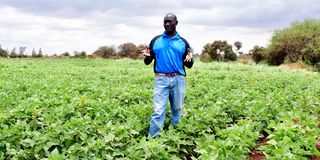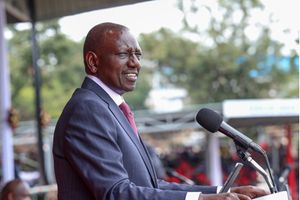Where farmers innovate solutions to tackle water scarcity and climate crisis
What you need to know:
- Patrick is among the farmers in the area who have adopted smart techniques to keep up with the changing weather that has cut their access to communal water.
- Walking us under a canopy of green bananas, he explains that he dug a well for domestic and agricultural use and he no longer seeks the shared commodity.
Driving through Kimana in Oloitoktok, Kajiado County, the stark difference in farms strikes us - some are as green as a lush, untamed jungle, while others lay bare and brown.

Patrick Saitabau checks on his water reservoir built for collecting water at his farm in Kimana.
At Patrick Saitabao's farm, we are astounded by the variety of prospering crops, yet nearby farms look battered in the dry weather. His farm is green all year round, with plenty to harvest, from bananas to vegetables and fruits. The fresh air buzzing with bees is almost surreal.
Patrick is among the farmers in the area who have adopted smart techniques to keep up with the changing weather that has cut their access to communal water. He does not let that stand in the way of his farming. Walking us under a canopy of green bananas, he explains that he dug a well for domestic and agricultural use and he no longer seeks the shared commodity.
"The communal water no longer reaches us, especially with inadequate rains and the many construction projects in the area. I had to devise ways to keep farming," he explains, leading us to the well. An electric pump hums quietly, sending water to a raised reservoir. He says it was a costly installation that took him four years to complete.
The many fish playing close to its surface catch our attention as we approach the reservoir. Made from gurney bags filled with soil, stacked atop each other, and covered in a giant trampoline, the pool holds approximately 30,000 to 40,000 litres of water. Kimana wasn’t always this hot and dry. The area was previously known for its abundant water, and residents didn’t need to conserve the commodity for survival.
"Oloitoktok means water springs, which is what Kimana used to be: a source of plenty of underground water. With climate change and an ever-growing population, that is no longer a fact," says Emmanuel Tarsaloi. As the region's Water Use Association Lead, Emmanuel has witnessed residents struggle as the water that used to flow freely becomes scarcer every day. Water conflicts are slowly emerging as people come to terms with the change. Rationing is now in effect - some residents go up to two weeks without water.
He explains that the Kimana Water Canals Project was set up in 1982 to combat water conflicts that had ridden the area, leading to deaths. It channels water from underground springs to different homes and farms. With their origins on the slopes of the majestic Mount Kilimanjaro, several springs have sustained the community for ages. However, most of them are on the brink of extinction.

Water being pumped into a water reservoir for use lat a farm in Kimana, Loitoktok on September 15, 2023.
"Of the three significant springs, two are running dry as people have cut trees, exposing them. As people settle around them, land encroachment threatens water access as people start owning the springs. Today, we have had to ration water due to the effects of climate change. In the past, conflicts were common among pastoralists as they fought to water their animals. Today, it is a war of elites as those who can bribe their way into getting more access than others, do,” explains Emmanuel.
Emmanuel cites regular attempts by regional elites to fence off the springs. He is optimistic, however, after seeing many farmers in the area adopt water conservation methods. This is the case at George Musa's bean plantation. Another former pastoralist turned smart farmer, George maximises his rationed water by channelling it into a reservoir. He uses solar power for drip irrigation.

George Musa, a farmer, talks about the benefits of using drip irrigation as a way to efficiently use water and avoid wastage, at a farm in Kimana Loitoktok on September 15, 2023.
George explains that initially he used a generator to power the entire system. This was expensive mainly because fuel prices are constantly on an upward trajectory. The expense advised the installation of solar panels that now circulate water at almost zero cost. George, who has since mastered drip irrigation installation skills and works part-time installing the same for others, says he has seen a big difference in yields.

Michael Kangethe (right) with his son Samuel Njenga inspect their French beans farm in Kimana, Loitoktok on September 15.
"Initially, I adopted the flood irrigation technique, where I would plant in shallow basins that required much manual work to let water in. This consumed a lot of water and it was too exhausting. It also encouraged weeds as the water in the basins was not plant-targeted. Today, I use water only at the plant’s roots. This saves it while reducing weeds," George explains.
Water conservation is just one of the many adaptation techniques these farmers employ. To ensure maximum yields, they plant drought-resistant crop varieties. Working with private investors, they identify crops best suited for the soil in the changing climate and get access to information such as the pesticides to use and even a link to the market for their produce.
Gerald Mutua, CropCare Technologies managing director and an agribusiness strategist, has worked with farmer clusters in Kimana for four years on projects like seed propagation and crop protection solutions.
"Other than using fewer chemical inputs, we have seen an increase in yields for healthier food in the regions," Gerald explains, mentioning that most farmers were reluctant to try smart farming when the cluster education began.
The firm seeks to attain Sustainable Development Goals 2, 12, and 13 -Zero Hunger, Responsible Consumption and Production, and Climate Action - respectively. A youth farmer, Daniel Moriati, says his training has taught him the best crop varieties to plant.
"I have learned that farming is profitable using the correct inputs and applying efficient harvesting and post-harvesting techniques. I especially gained a lot of valuable knowledge on the post-harvest handling of onions", Daniel explains.
Ernest Njogholo, the area's long-time agricultural officer, says more farmers are switching to smart methods after seeing those who pioneered succeed. Having served as an agriculturist in Kimana for over 10 years, Ernest has witnessed the water crisis worsen, forcing the need for innovative solutions.
"We now have to ration the water from our canals. When the canal opens and it's your time, you get enough water to flood your farm, but only temporarily. This is inconvenient since you can barely do much in such a short time. Sometimes, your turn comes at night, and all the water goes to waste," Ernest says. The now-retired agricultural officer explains that the farmers have developed water collection reservoirs that allow them to save and use water when appropriate without wasting it.
The Food and Agriculture Organisation (FAO) supports such farmer initiatives as it cautions about impending water availability disparities. A recent FAO report highlights climate change's impact on water resources, emphasising altered rainfall patterns and the need for participatory approaches in infrastructure management.
Farmer-managed systems, the FAO says, offer effective collective management, often in collaboration with private sector contractors or water-user associations. These systems thrive with well-defined property rights and legal recourse mechanisms, ultimately promoting water productivity. The report states: "Farmer-led systems work best with clear property rights and dispute resolution mechanisms, which are crucial for water productivity by ensuring reliable irrigation water availability."





